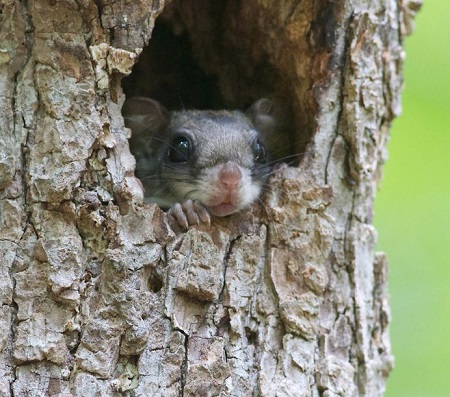Flying Squirrels Wow the Crowd
 Flying Squirrel photographed in Dyke Marsh. Photo by Ed Eder
Flying Squirrel photographed in Dyke Marsh. Photo by Ed Eder
On February 17, 2021, 89 people became instant fans of the native southern flying squirrel (Glaucomys volans) thanks to a much-applauded Zoom presentation by naturalist Kim Young, from Fairfax County Park Authority’s Hidden Oaks Nature Center.
Ms. Young detailed the identifying characteristics, behavior, diet and habitat of these members of the rodent family, animals that weigh about the same as a cellphone, 2 ½ ounces, and are eight inches long, with their tail being from a third to a half of that length.
Other highlights:
- Flying squirrels are nocturnal, arboreal mammals, that often go undetected because they are active at night and usually high up in the canopy.
- The flying squirrel’s gray-brown fur easily camouflages against tree trunks. Their belly is white and they have large eyes in proportion to their bodies.
- A telltale sign of flying squirrels is the acorn debris they leave behind. Unlike other rodents that completely destroy acorns, flying squirrels make a round oval hole in the acorn when they probe for nutmeat and beetle larvae. They store nuts in nests, cracks, cavities and tree forks.
- They are expert gliders because of their “wings,” the two membranes between their ribs and ankles that in effect form a parachute. Their flight is not powered flight, which involves flapping, like that of birds, insects and bats. They glide and steer with their tail and legs.
 Flying Squirrel. Photo by Ed Eder
Flying Squirrel. Photo by Ed Eder
Ms. Young sings their praises. “They’re the cutest little mammal I’ve ever seen, charismatic,” she told the group. “They remind you of what an incredible world we have.”
Hidden Oaks Nature Center plans several flying squirrel programs in March. Visit https://www.fairfaxcounty.gov/parks/hidden-oaks.
You can view the presentation here. Our speaker showed three videos which we have not included in this Zoom recording.

 Friends of Dyke Marsh, Inc. is a non-profit 501(c)(3) organization.
Friends of Dyke Marsh, Inc. is a non-profit 501(c)(3) organization.